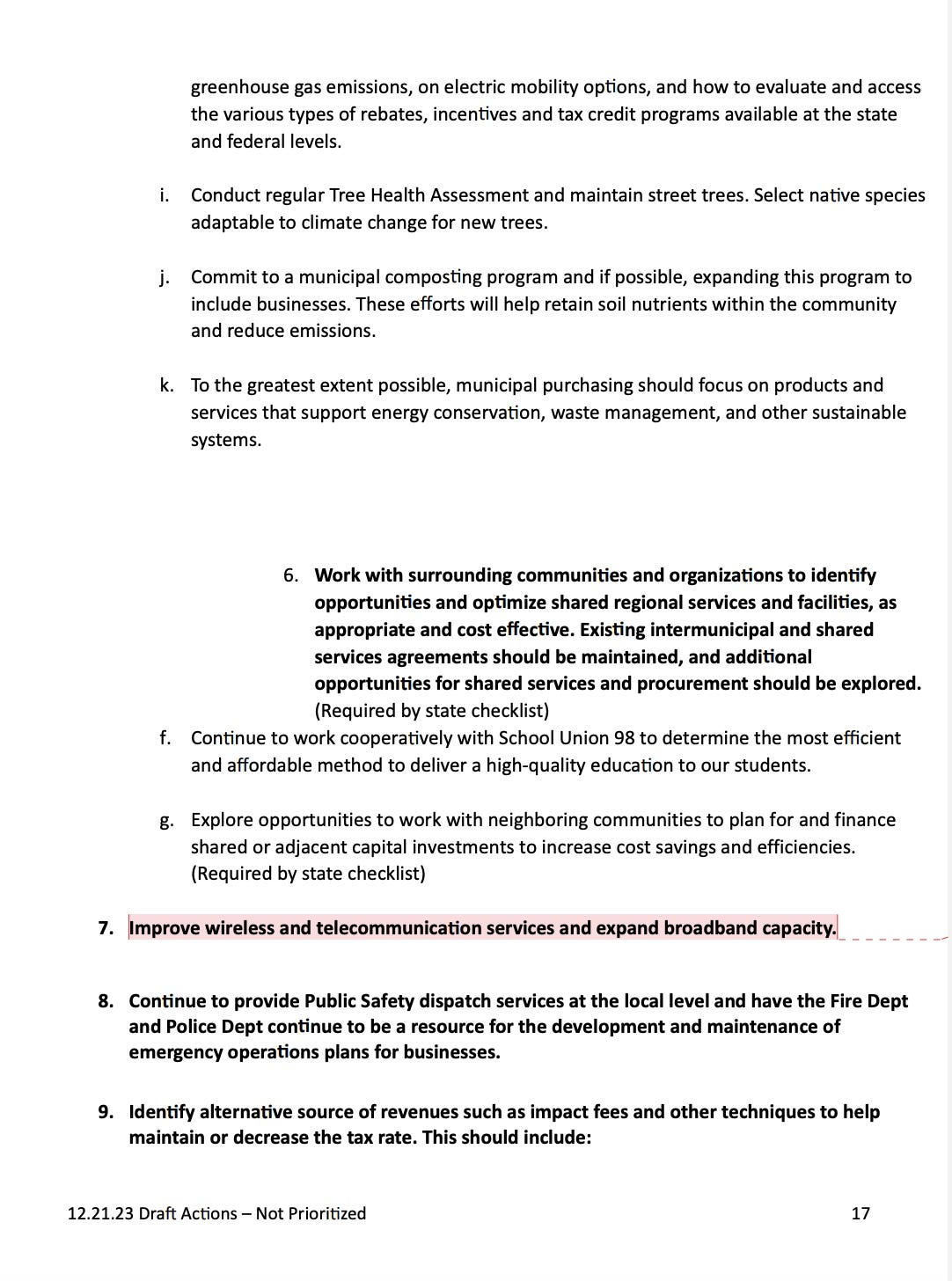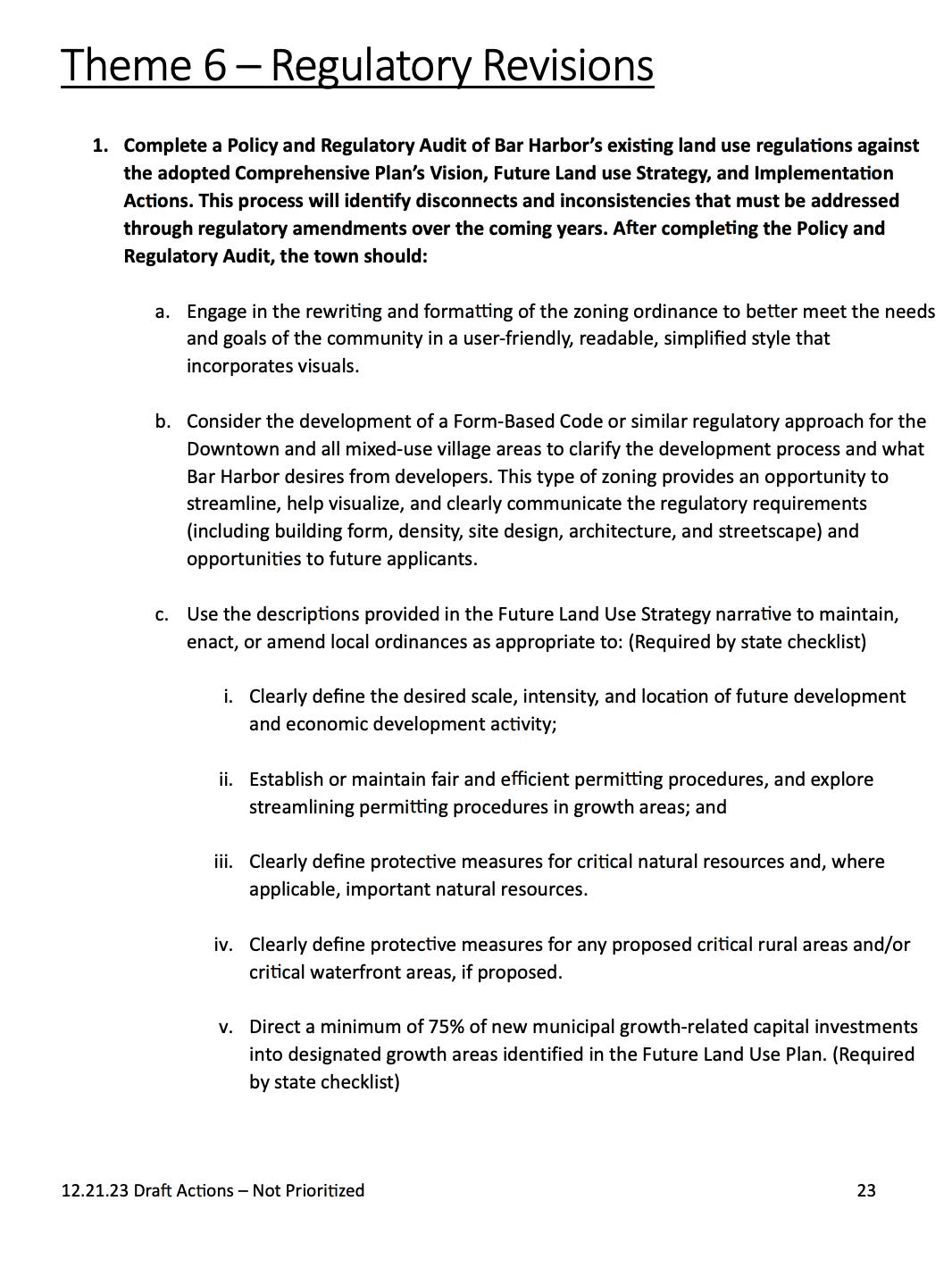Bar Harbor's Comprehensive Plan Is Shaping Up
Council sees project timeline, committee works on themes
BAR HARBOR—Bar Harbor does not expect to spend any more money on the creation of its next Comprehensive Plan.
After being presented with an updated timeline on the work to create a state-approved plan to guide Bar Harbor’s future development and infrastructure, Councilor Kyle Shank (who is a former chair of the committee and still on it) asked if there was an expectation of more payments next year for the consultants leading the process. Town Planner Michele Gagnon said that there are not.
Resilience Planning is the consulting firm for the project. Its contract was extended in December 2022 to allow the committee to gather more public input, data, and to work on the plan for a longer period. That extension also came with an additional $100,000 from the town’s budget.
At their January 16 meeting, councilors heard an updated timeline for the town’s Comprehensive Planning process with hopes for a May draft.

Councilor Maya Caines said the timeline has shifted enough so that voters won’t be able to vote on the plan in June 2024 when it was hoped to be voted on.
“At this town meeting, no, it won’t be ready,” Shank said.
Shank said that the timeline has indeed extended and the plan won’t be ready for the town meeting in June. The state takes months to review the plan. Gagnon said the timeline hasn’t shifted in the last year, though it has shifted from its original timeline, but she apologizes if it felt like it shifted.
Caines also worried about how the shift in timeline would impact the Council’s ability to do work.
In the second half of 2024, the town will be rolling out the plan and explaining what it entails. During that time and before its adoption, Gagnon said, the plan could be still looked at for guidance.
“I don’t think that it means that you can’t use the document for guidance; it’s just not formally adopted,” Gagnon said and said elements of the plan are currently guiding the town.
Originally, the town recruited candidates to serve on the committee and said it expected the committee to meet about 15 times between December 2021 and February 2023. The amount of public comment needed, desire to engage the public, the creation of an existing conditions report and housing surveys and Bar Harbor’s unique nature have all been cited as reasons for the additional amount of time that the plan’s drafting has taken.
The last plan was in 2007. The plans are meant to guide the town’s priorities and goals for about ten years from its start date, Gagnon has said.
THE PLAN ITSELF AND HOW IT’S SHAPING UP
No more acronyms; as clear language as possible; what “high density” means in the downtown rather than rural areas; what a “tourism development district” might be; where and how much lodging the town should have and quantifying the town’s capacity for it; the Comprehensive Planning Committee met on January 10 and discussed it all in rather poignant timing after a massive storm rushed through Mount Desert Island and Maine earlier in the day, a storm that highlighted current and future infrastructure needs for a committee that’s purpose is to plan for Bar Harbor’s future.
The committee continued its work on fine-tuning the draft of themes for the plan. These themes act as containers to discuss different areas of the town’s direction toward the future.
Part of guiding that future is understanding the how and why of Bar Harbor having approximately 40 different zones. Each zone has different rules for what is allowed to be built within the zone and what uses different buildings can have.
When asked by Planning Director Michele Gagnon about how they feel about the number of zones Bar Harbor has and if they should merge, committee members talked about the character of zones and neighborhoods and the inability to prioritize uses when there are so many zones, and the time it takes to understand zones and undergo projects. Each zone, Town Councilor and Comprehensive Planning Committee member Kyle Shank said, should have a value to being zoned differently.
“If there’s no value driven from it, it probably just exists for some other reason,” Shank said.
Often, Planning Board Secretary and Comprehensive Planning Committee member Elissa Chesler said, zones were created so that an owner could continue to use their property without becoming nonconforming. There’s a tension that will happen when zones are merged when it comes to that nonconformity, she said. “A solution might be to look at what opportunities and ways…what could be allowed when people end up in nonconforming uses.”
Non-conforming uses are sometimes called grandfathered uses. They usually occur when the land or structure in a zone was legal when it first was used or built, but then doesn’t comply with the current zoning standards. It can be about a use or a lot or a structure. When towns change a zone’s allowed uses (is a gas station allowed, a hotel, a farm) or character (how close buildings can be together, for example, what are the shoreland restrictions), it can prevent further enlargement of current uses (no more hobbit houses or multi-storied hotels or gas stations). This is a way that towns and cities can shape the character of a town.
“We’ve over-legislated through our zoning ordinance,” Shank said.
“When a municipality has a vision, one way to accomplish that vision is through zoning,” Gagnon said, and one way that can happen is by allowing nonconformity. Nonconforming uses can exist, but they can’t expand when approached that way. “Those are big questions that are going to have to be looked at” for Bar Harbor’s future, she said.
During the discussion of the themes, Ruth Eveland as a member of the public, and committee members talked about decreasing the number of acronyms used in the language, as well as adding in various aspects to the plan.
Eveland spoke about adding in the Jesup Memorial Library’s intent for its expansion to be a demonstration of a sustainability of a public space and building.
THEME 3 - PEOPLE-CENTERED TRANSPORTATION
Committee member Mike McKernan said that there should be a specific mention of the multi-million dollar Acadia Gateway Center set to open in Trenton in May 2025. The goal of the center, stated decades ago, was to decrease the vehicular congestion in Acadia National Park and allow for commuter and visitor parking. The land for the center was purchased in 2004. It will host the Island Explorer bus hub and a park-and-ride, and have a 500-vehicle-capacity lot.
Both Parks and Recreation Chair and committee member John Kelly (who works at Acadia National Park) and Shank agreed that working with Acadia’s transportation programs and the Island Explorer system and other public transportation systems should be in the plan.
Acadia Gateway is one of many Maine Department of Transportation (MDOT) projects that impact the region. Others include the route improvements on Route 3 and Cromwell Harbor bridge on lower Ledgelawn Ave.
Kelly talked about including the ferry terminal/marina in the transportation theme.
School Board member and committee member Misha Mytar spoke about safely connecting where pedestrians go, particularly children or seasonal workers that don’t have cars, as well as the need for more pedestrian signs. She asked for more Bar Harbor specific language.
Board members also talked intersections and two town grants the town has to deal with pedestrian and bicyclist safety.
“I think the idea of what we hear about in the community is just having no cars on the street,” Mytar said and asked how to move it forward beyond a Facebook chat, saying it comes up all the time.
THEME FOUR: COMMUNITY SERVICES AND FACILITY
Shank suggested potentially taking out the word “tourist” here. Chesler talked about the renovations on the second floor in the municipal building and sewer system connections, which she said should be more thoughtful about providing town sewer and water for Town Hill if that’s going to become a growth area. Shank suggested included investigating the inventory of capacity of sub-surface wastewater systems in the area, which Gagnon said the state has really strict laws about.
Kelly suggested putting in a bullet point for the MDI YMCA and working with it to continue its services. Mytar talked about how the infrastructure and programming is provided by town partners like the Village Improvement Association and Acadia Youth Sports and how the challenge is the communication and coordination between those services. Mytar suggested looking into how to be the best partner of those spaces and how to better coordinate and communicate. An example, she said, is who to ask if Glen Mary is opening for skating. When people have that question, she said, they don’t know who to ask.
“I don’t want to make it a negative thing at all. We have a huge asset through all these partners,” Mytar said.
Shank also spoke about better integrating island-wide cooperation in public safety and whether to be really explicit about it in the plan. He referenced how Tremont doesn’t have its own police force and how the Southwest Harbor Police Department is understaffed.
“I think we need to start thinking differently,” Town Council Chair Valerie Peacock said about “planning for a different future of resilience” in places like Ells Pier, which took a brunt of storm surge during the January 10 storm.
THEME FIVE: A DIVERSE ECONOMY
Shank wanted to make sure that things written in the plan’s themes can legally be done by the town, and he questioned if the plan should be specific. He referenced a bullet point that discusses a 1.5% tax on hotel bookings and being hesitant unless the town is positive that it can do that.
Mytar said in many of the sections it seems as if revenue-generating recommendations are buried. She wondered if those warranted their own sections to highlight them.
There was discussion about the wording regarding encouraging payments in lieu of taxes from nonprofit programs.
“You don’t want to feel like you’re shaking down the Food Pantry for money in a bullet point in the Comp Plan,” Shank said.
THEME SIX: REGULATORY REVISIONS
Shank and Kelly were both in favor of adding language about simplifying or reducing the number of zones.
Chesler suggested making sure that the “driving purpose” for making the changes was important.
Aspects about the form of government and how it works in Bar Harbor is a bullet point in the plan. What the bullet point should be linked to, Gagnon said, is a charter discussion rather than a form of town government. A past survey of residents in 2019 had questioned if they wanted to continue the town’s current form of government, which involves town meetings, the path of land use ordinance changes, and a town council and warrant committee.
A FEW EVENTS AND BRIEFS WE RECEIVED AFTER MONDAY’S “ON THE AGENDA”
Uncover the essentials of entrepreneurship with three workshops from SCORE Maine. First, "Starting Your Own Business" guides aspiring entrepreneurs through crucial questions, dispelling myths, defining value propositions, and addressing legal and financial fundamentals. Next, in "Your Business' Financial Health Measured by Eight Key Accounts," \SCORE Mentor Whit Ford explores the impact of changes in key financial statement accounts on your business's financial health, including revenues, margins, and assets. Lastly, "Hiring Your First Employee," led by SCORE Mentor and HR Professional Danielle Nemeth, addresses the complexities of bringing on staff, offering HR basics and valuable insights for new business owners navigating the hiring and management process. Whether you're starting out or already on your entrepreneurial journey, these workshops provide practical knowledge and mentorship to empower your entrepreneurial journey.
LINKS TO LEARN MORE
https://www.barharbormaine.gov/AgendaCenter/ViewFile/Agenda/_01102024-3336
Comprehensive Plan Committee Receives More Funds To Continue Work Read full story
Website dedicated to Bar Harbor’s Comprehensive Plan project.
Existing Conditions Analysis Report






























